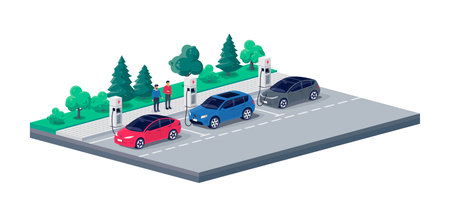1. Understanding Common Road Hazards
When youre on the road, various hazards can appear at any moment. Recognizing them early helps you stay safe and avoid accidents. Here are some of the most common dangers you might face:
Weather Conditions
Bad weather can make driving more challenging and increase the risk of accidents. Different weather conditions affect the road in various ways:
| Weather Condition | Hazards | How to React |
|---|---|---|
| Rain | Slippery roads, reduced visibility | Slow down, use headlights, maintain a safe following distance |
| Snow & Ice | Poor traction, increased stopping distance | Drive slower, avoid sudden braking, use winter tires |
| Fog | Severely reduced visibility | Use low-beam headlights, drive cautiously, follow road markings |
| Strong Wind | Difficulty maintaining control, hazards from flying debris | Keep a firm grip on the wheel, be cautious near large vehicles |
Reckless Drivers
Not all drivers on the road follow traffic rules. Some engage in aggressive or careless driving, creating dangers for others. Here are some common reckless driving behaviors:
- Speeding: Drivers going too fast for conditions or ignoring speed limits
- Tailgating: Following too closely, reducing reaction time
- Swerving: Sudden lane changes or erratic movements
- Ignoring Traffic Signals: Running red lights or stop signs
To stay safe around reckless drivers, keep a safe distance, avoid aggressive interactions, and be prepared to brake or change lanes if necessary.
Road Obstructions
Obstacles on the road can appear suddenly and pose dangers. Common road obstructions include:
- Potholes: Can damage tires and suspension
- Debris: Fallen branches, rocks, or vehicle parts
- Construction Zones: Narrow lanes, detours, and uneven surfaces
- Pedestrians & Cyclists: Unexpected crossings or riding in the roadway
Always stay alert, scan the road ahead, and adjust your speed when navigating potential obstacles.
2. Developing Defensive Driving Skills
Defensive driving is all about staying alert, predicting potential hazards, and taking proactive steps to avoid accidents. By mastering a few key techniques, you can significantly reduce your risk on the road.
Maintaining a Safe Following Distance
Keeping a safe distance from the vehicle in front of you gives you more time to react if something unexpected happens. The general rule is the “three-second rule,” which means you should stay at least three seconds behind the car ahead. In poor weather conditions, increase this distance to five or more seconds.
| Road Conditions | Recommended Following Distance |
|---|---|
| Normal (dry pavement) | 3 seconds |
| Rain or wet roads | 5 seconds |
| Snow or icy roads | 7+ seconds |
Scanning the Road Ahead
Continuously scanning the road ahead helps you spot hazards before they become dangerous. Instead of just focusing on the car in front of you, look 10 to 15 seconds down the road. This allows you to anticipate slow traffic, road debris, or sudden stops.
How to Improve Your Scanning Technique
- Check mirrors every few seconds to stay aware of surrounding traffic.
- Look ahead for brake lights, lane changes, or erratic driving behavior.
- Be mindful of pedestrians, cyclists, and other road users.
Anticipating Potential Dangers
Experienced drivers can often predict risky situations before they happen. Being proactive means recognizing potential hazards and adjusting your driving accordingly.
Common Driving Hazards to Watch For
- Intersections: Always be cautious at intersections, even if you have the right of way.
- Blind Spots: Check over your shoulder before changing lanes to avoid missing vehicles in your blind spot.
- Aggressive Drivers: If someone is driving aggressively, give them space instead of engaging.
- Weather Changes: Adjust speed and following distance during rain, fog, or snow.
- Road Construction: Slow down in construction zones and watch for sudden lane shifts.
By developing these defensive driving habits, you can stay safer on the road and reduce your chances of encountering dangerous situations.
![]()
3. Recognizing and Reacting to Sudden Hazards
While driving, unexpected situations can arise at any moment. Knowing how to recognize and react to sudden hazards can help you stay safe on the road. Whether it’s abrupt braking, road debris, or an unexpected pedestrian, quick decision-making is essential.
How to Respond to Sudden Braking
When a vehicle in front of you stops suddenly, your reaction time is critical. Follow these steps to handle the situation safely:
- Maintain a safe following distance to allow enough stopping time.
- If the car ahead suddenly stops, apply firm pressure to your brakes while keeping control of the vehicle.
- Avoid sudden swerving, as this may put you in the path of another vehicle.
- Always check your rearview mirror before braking to ensure vehicles behind you have time to react.
Dealing with Debris on the Road
Encountering objects on the road can be dangerous if not handled properly. Here’s how to react:
| Type of Debris | How to React |
|---|---|
| Small debris (plastic bags, paper, etc.) | Hold the steering wheel steady and drive over it cautiously if unavoidable. |
| Medium debris (branches, small objects) | Slow down and check for a safe way to avoid the object. |
| Large debris (metal objects, tires, fallen cargo) | Never try to drive over large objects. Signal and safely change lanes or stop if necessary. |
Reacting to Unexpected Pedestrians
Pedestrians can sometimes cross unexpectedly, especially in urban areas. To reduce the risk of accidents:
- Always be aware of crosswalks and pedestrian signals.
- Reduce speed in areas with high foot traffic.
- If a pedestrian suddenly steps into the road, brake firmly without swerving.
- Be extra cautious around schools, parks, and residential areas.
Final Tips for Handling Sudden Road Hazards
Being prepared for the unexpected is key to staying safe on the road. Always keep both hands on the wheel, stay alert, and anticipate possible hazards ahead. A calm and controlled response can prevent accidents and ensure your safety.
4. Adapting to Different Driving Conditions
Driving conditions can change quickly, and being able to adjust your driving based on the weather or time of day is crucial for staying safe on the road. Here’s how you can prepare for different scenarios like heavy rain, fog, snow, and night driving.
Driving in Heavy Rain
Rainy conditions can lead to reduced traction and visibility. Roads become slippery, increasing the risk of hydroplaning. To drive safely in heavy rain:
- Slow down to prevent hydroplaning.
- Keep a greater distance between you and the vehicle ahead.
- Use headlights to improve visibility, but avoid high beams.
- Check windshield wipers regularly to ensure they work effectively.
Driving in Fog
Fog significantly limits visibility. To navigate safely in foggy conditions:
- Use low-beam headlights and fog lights, never high beams.
- Reduce speed to allow for unexpected obstacles.
- Follow road markings to stay in your lane.
- Use extreme caution at intersections and turns.
Driving in Snow and Ice
Snow and ice can cause slippery roads and reduce overall control of your vehicle. Here are some tips for driving in these conditions:
- Drive slowly and accelerate or brake gently.
- Increase the following distance to allow more stopping time.
- Use winter or all-season tires for better grip.
- Avoid sudden turns or sharp movements that may cause skidding.
Night Driving
Reduced visibility at night makes it harder to see hazards. Improve your night driving safety by:
- Using headlights from dusk till dawn.
- Reducing speed to allow for better reaction time.
- Keeping your windshield clean to prevent glare.
- Avoiding looking directly at oncoming headlights.
Quick Guide for Different Conditions
| Condition | Key Adjustments |
|---|---|
| Heavy Rain | Slow down, use headlights, avoid sudden braking. |
| Fog | Use low beams, reduce speed, follow road markers. |
| Snow/Ice | Drive slowly, increase following distance, use winter tires. |
| Nighttime | Turn on headlights, reduce speed, minimize glare. |
By adjusting your driving to different conditions, you can improve road safety for yourself and others. Always stay alert, adapt as needed, and be prepared for sudden changes in the environment.
5. Staying Calm and Making Quick Decisions
When faced with unexpected hazards on the road, staying calm and making quick decisions is crucial. Panicking can lead to overreactions, which might make the situation worse. Instead, its important to stay composed, assess the hazard, and react in a controlled manner.
How to Stay Composed in High-Stress Situations
Driving can be stressful, especially when unexpected hazards appear. Here are some ways to stay calm under pressure:
- Take deep breaths: If you feel yourself getting anxious, take slow, deep breaths to stay focused.
- Maintain a steady grip on the steering wheel: Avoid sudden or jerky movements, which can lead to loss of control.
- Keep your eyes on the road: Scan ahead and remain aware of your surroundings.
- Remind yourself to stay in control: Confidence in your driving abilities will prevent panic.
Making Quick Yet Controlled Decisions
When a hazard appears, you need to make a decision fast. Here’s how you can ensure your response is both quick and effective:
- Assess the situation: Determine what the hazard is and how it affects your path.
- Evaluate your options: Choose the safest course of action—whether it’s braking, steering, or accelerating to avoid danger.
- Stay predictable: Avoid sudden or erratic movements that could confuse other drivers.
Common Hazards and How to React
Different hazards require different reactions. Here’s a breakdown of common road hazards and the best way to handle them:
| Hazard | How to React |
|---|---|
| Sudden stop by the car in front | Keep a safe following distance and apply brakes smoothly. |
| Pedestrian crossing unexpectedly | Slow down and be ready to stop, giving them the right of way. |
| Debris on the road | Scan ahead and gently steer around the obstacle without sudden movements. |
| Animal crossing | Slow down safely but avoid swerving excessively, as that can cause loss of control. |
| Slippery or wet roads | Reduce speed gradually and avoid sudden braking to prevent skidding. |
Avoiding Overreactions
Overreacting to hazards can sometimes cause worse consequences than the hazard itself. Here’s what to avoid:
- Swerving abruptly: Instead of jerking the wheel, make smooth and controlled movements.
- Slamming on the brakes unnecessarily: Hard braking can cause skidding, especially on wet or icy roads.
- Following too closely: Keeping a safe distance helps prevent the need for sudden stops.
- Taking your eyes off the road: Always stay alert to react appropriately.
Practicing for Emergency Situations
One of the best ways to handle road hazards calmly is through practice. Consider these methods:
- Drive in different conditions: Get experience in rain, snow, or heavy traffic to build confidence.
- Take a defensive driving course: Professional training can help refine your quick decision-making skills.
- Run through mental scenarios: Imagine different hazards and think about the best responses before they happen.
By staying calm and making quick yet controlled decisions, you can navigate hazardous situations more safely. Avoid overreacting, assess the situation carefully, and always prioritize smooth and predictable movements on the road.


